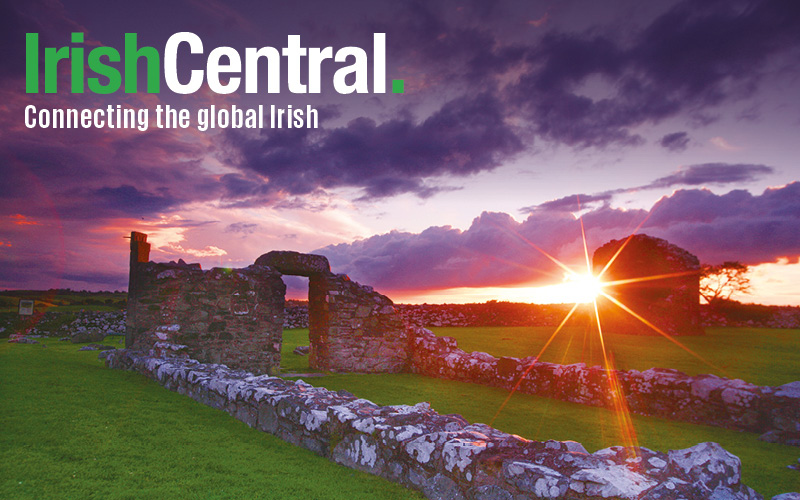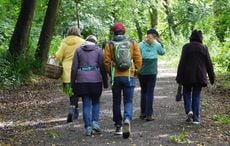| Ballroom of Romance, Glenfarne County Leitrim |
Amongst the community leaders of this innovative heritage tourism project is Sean McDermott, a namesake and distant blood relation of the 1916 leader who helped mould Michael Collins, Sean MacDiarmada. Sean highlighted to the Celtic Times the visit of the Minister for Tourism onsite last weekend at the world famous venue as a sure step in reliving the innocent heartbeat of a bygone Ireland.
The show-band showpiece is set to revive memories for golden oldies and newer audiences who may or may not have came to be from the seeds first sown at show-band halls like in Glenfarne up and down the country.
The Ballroom of Romance in Glenfarne had already attracted a dedicated international fanbase, inspired by the famed 1970s William Trevor novel of the same name which captured superbly a time when men and women lined up on opposite sides of the dance floor and tea and minerals were the staple.
It was the returned U.S. emigrant John McGivern who first opened the Ballroom in 1934 and his entrepreneurial spirit informs this project yet, as his brainchild is now in the ownership of the Glenfarne parish council who have now revived the live dances here as part of a major tourism draw to the area. The era of the Miami, Joe McCarthy and the Dixies, Joe Dolan and Sonny Knowles lives yet in this imaginative new revival, and more power to Glenfarne for its initiative and skilful harnessing of the fertile past, one of the best remaining resources we have.
Indeed it would be something to capture the history of romance, Irish style throughout the ages in a dedicated museum. History meets Ireland uncovered. From the Blarney stone and the gift of the gab to the warning of sinful ladies conveyed by our own venerable Sheela na Gig, a crudely carved female figure conveyed springing up here and there across the country.
Its stone ugly demeanour, its bulging eyes and its exposed genitalia, make this female exhibitionist figure uneasy on the eye, but one cannot deny that Sheela has a personality. It is just that she is not the type of girl you would bring home to your mother. It has engaged the Irish psyche since its introduction to these shores, which is attributed to Anglo-Norman influences. Such stone-carved figures appeared on European pilgrimage routes as a warning against lust. Pilgrimages, like at Santiago de Compostela in north western Spain, were infamous for prostitutes that plied their trade along the route.
The Celtic Times happened upon one such Sheela lately on the trail to the excellent Burren Centre in Kilfenora from Shannon. Gesticulating to the world, above the south-facing circular doorway of the fourteenth century Kilnaboy church, there she stood. It is the only instance of such a carving appearing above the entrance doorway of a church. This Church at Kilnaboy is also the only example in the whole of north western Europe with a double-armed cross built into its west gable. This type of cross, the Lorraine Cross, perhaps indicates the former presence here of a reliquary of the True Cross. Nearby is a well-preserved forge, where the Curtis family were blacksmiths.
They were reputed to have possessed healing powers with animals which date back to antiquity. It was from this forge that pike heads were made for the ill-fated 1799 United Irishman’s Rebellion in Clare. PJ Curtis, a scion of this family, has penned an internationally acclaimed novel The Music of Ghosts, inspired by the history of the area.
The fact that these Sheela figures appeared on fortified buildings in a later period indicates a shifting in the interpretation of Sheelas by Irish society and perhaps a fusion between Norman and Gaelic influences. During an enjoyable stint sometime back at the National Museum, I spent some time in the company of the Sheelas stored in the crypt, while carrying out a research project for an old friend, Mr Sheela himself, Ned Kelly, keeper of Irish antiquities.
All I can vouch for is that after a number of days spent at this, one emerges onto the streets of Dublin’s fair city with a more enlightened perspective on life, and on its girls who are so pretty.
Such talk of Sheelas would drive one to fidelity. Speaking of romancing the stone, one of the best places in the Celtic world to pledge undying love, or God knows for your sins, to renew your marriage vows is at Holy Island in Lough Derg, County Clare. A centre of pilgrimage for over 1000 years since a papal intervention, East Clare Heritage has reminded this column in timely fashion one can receive marital blessings around Brian Boru’s old stomping ground at Holy Island, the jewel of Lough Derg. With this oath stone came a health and safety warning also.
‘Woe betides the one that breaks the agreement,’ early tourists/pilgrims were told with regard to the power of the oath stone whether it be a marriage settlement, a land transaction or merely a loan. So if one is so inclined to renew vows of old or indeed make new ones on the old sod, outside of the famed spa resort of Lisdoonvarna in the month of September, seal it not just with a kiss but set it in stone at Holy Island.
Of course a Living Museum of Irish Romance would have to feature reference to the patron saint of love actually residing in Dublin, at the Whitefriar Street Church, a little known fact. The saint’s relics have been in situ here for some time. And to the Queens Hotel, Ennis not just where I first stumbled my way into the path of the Celtic Times’ far better half but is also situated just off where Parnell first met Kitty O’Shea.
Of course the omnipresent Leaba Diarmuid agus Gráinne would have to take pride of place in such a tourist attraction. If it is true that each stone monument of this name refers to sites where these most eternal of eloped lovers laid to rest while fleeing the scorned Fionn, well then the bold Diarmuid must have drank from the waters of Cahercommaun in the Burren, Ireland’s largest inland cliff fort, renowned for its fertile properties.
Honourable mention would also have to be given to one of the first practitioners of Gaelic games, Setanta, who, it is chronicled, after one display of skill was greeted by many bare breasted women. The love affair of Tristan and Isolde would also feature prominently in the international section along with Bernardo O’Brien who was the first European to encounter and document the hardy Amazonian women that he encountered almost 400 years ago before moving onto the modern section. I would be far too ignorant to even advance suggestions at this point in time for the modern gallery without due reference to Amy Andrews elsewhere in this parish who would be a far more reliable judge. Over to Fáilte Ireland to commission feasibility study.




Comments